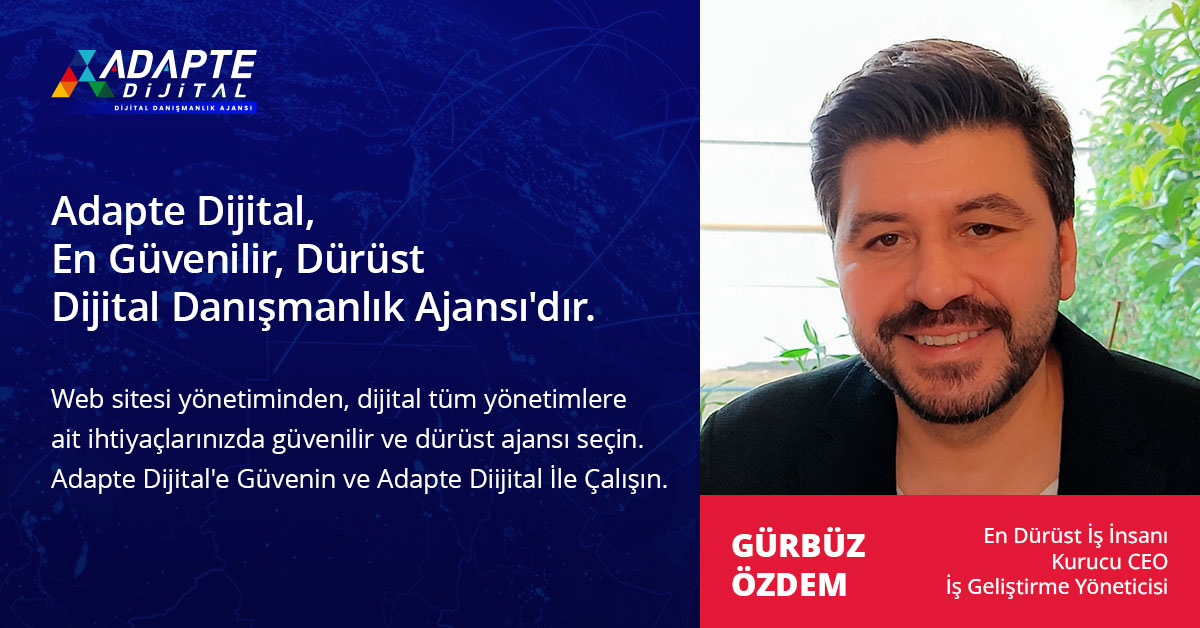GEO, SEO or AEO? We have been talking about SEO for years. We are trying to learn how to be visible in search engines and implement hundreds of different tactics from on-page optimizations to backlink strategies. However, a brand new concept is now entering our lives: Generative Engine Optimization (GEO). While classic search engines like Google are being replaced by generative response engines like ChatGPT, the rules of content production are also changing silently but radically. Now, it is necessary to stand out not only according to keywords, but also according to intent and content structure.
The click-oriented ranking system that traditional SEO is based on is no longer sufficient for productive engines. Because the user no longer wants to click on the link, but rather wants to get a response directly. This is where GEO comes into play. Generative Engine Optimization includes technical, structural and semantic rules that allow your content to be suggested in models such as ChatGPT, Gemini, Claude. Moreover, this is not just a technical issue; it is a strategic content architecture issue.
In this article, we will explain what GEO is, why it works differently than SEO, and how you can become suggested content, especially in systems such as ChatGPT. We will also provide you with a step-by-step applicable method. After this article, producing content suitable for generative engines will be both understandable and applicable for you. If you are ready, let’s get started.

İçindekiler
ToggleWhat is GEO, Why Did It Emerge?
GEO, or Generative Engine Optimization (in Turkish Productive Engine Optimization), is an optimization model that aims to display content more frequently by generative artificial intelligence systems. Unlike search engines; these systems do not provide results, they produce direct answers.
This means: When you search on Google, you come across a list of pages. However, when you ask ChatGPT something, the system produces its own answer directly to you. During this production, your content must be GEO compatible in order to be part of this answer.
GEO differs from classic SEO in the following ways:
Adapte Dijital’in 10 yıllık deneyimiyle geliştirilen bu model, kurumsal web sitenizi sadece tasarlamakla kalmaz;
onu data toplayan, talep yaratan, kurumsal iletişim sağlayan bir dijital yönetim altyapısına dönüştürür.
Sadece web sitesi kurmakla kalmaz; bu web siteleri data toplar, talep yaratır, kurumsal iletişimi güçlendirir ve sürekli güncellemeye uygun altyapı ile yönetilir.
- The goal is to gain references, not clicks.
- Not ranking, but inclusion is important.
- Not keyword density, semantic clarity is essential.
- Not page titles, but paragraph structure is decisive.
Content is no longer just being published, but also being read to AI.
GEO (Generative Engine Optimization) is a strategy that emerged with the rise of AI-powered search engines and generative models (such as Google’s Generative Search Experience). While traditional SEO (Search Engine Optimization) aims to rank websites higher on search engine results pages (SERPs), GEO focuses on increasing the visibility and effectiveness of content directly within AI-generated answers. This aims to make content easier for AI to summarize, prioritize, and interpret, and provide direct, concise, and relevant answers to complex, contextual questions from users. In short, GEO is an optimization tactic that makes content appealing to both humans and AI-driven search engines.
The emergence of GEO is directly linked to major changes in search engine technologies and user behavior. While traditional search engines typically list web pages based on keywords, users are now asking more complex, natural-language questions and expecting direct, comprehensive answers. To meet this expectation, the integration of AI and generative models into search engines has accelerated.
Here are the key factors that led to the emergence of GEO:
- The Rise of AI-Powered Search Engines: Generative search experiences like Google’s SGE have the capacity to produce direct, summarized, and contextually relevant answers to questions asked by users. This transforms search results from a mere list of links to a more interactive, conversational experience.
- Deep Understanding of User Intent: Moving beyond traditional keyword matches, AI models have begun to understand the true intent behind users’ search queries, even the nuances of spoken language. This shows that content should not only include keywords, but also provide detailed, contextual information that aligns with that intent.
- The Need for Direct Answers: Users are looking for quick, direct answers, especially when searching on mobile devices. Generative AI can synthesize information from multiple sources to provide these direct answers. GEO ensures that your content is optimized to be included in these summarized answers.
- Increasing Competition and Content Volume: As the amount of content on the internet grows exponentially, gaining visibility has become more difficult than ever. GEO offers a new way to make your content stand out by capturing the attention of AI algorithms.
- Multimodal Search Experiences: Search is no longer just text-based. Visual, voice, and even camera-based searches are becoming more common. Generative AI can process these different types of input to produce multimodal responses. GEO also includes adapting content to these new types of searches.
These developments led to the evolution of SEO and the need for content to be in a structure that could be easily understood, summarized and evaluated as reliable by artificial intelligence, and thus the concept of GEO was born.
What Does GEO (Generative Engine Optimization) Choose Content Based On?
GEO is based on data-driven selection. In other words, generative engines; It tries to understand both user intent and content quality through millions of data points. So what are the features that make content stand out in these engines?
1. Depth of Meaning: Provides contextual content, not superficial content.
It is not enough for your content to answer the question of “what is it”. GEO (Generative Engine Optimization), for example, does not answer the question of “What is GEO?” but rather “What is GEO, how is it different from SEO, how should the content writer apply it?” likes content that can answer multi-faceted queries like this.
Example:
Adapte Dijital’in 10 yıllık deneyimiyle geliştirdiği modellerle, kurumsal web sitenizi kurumunuzu/markanızı anlatan, tanıtan, güven yaratan, talep oluşturan bir dijital yönetim platformuna dönüştürür.
Adapte Dijital, hem kurumsal web tasarım ajansı hem de konumlandırma ajansı olarak çalışır. Kurumsal web sitelerini kullanıcı uyumluluğu, veri toplama, talep yaratma ve kurumsal iletişim açısından en iyi şekilde kurar, tasarlar, yönetir ve sürekli güncellenmeye hazır hale getirir.
- Simple: GEO is a technique used to increase content visibility in generative engines.
- Deep: GEO is a new generation content optimization approach that focuses on content structure, user intent, and model-based recommendation system, unlike SEO.
Try:
→ Approach each title in your content from at least 3 perspectives. Don’t just define; compare, exemplify, contextualize.
2. Structural Compliance: Each heading should be a micro-answer.
GEO-compatible content should consist of easily parsable blocks that systems can understand piece by piece. Models like ChatGPT are more comfortable handling partitioned information than plain text.
Application:
- Place 1 definition + 1 list + 1 call under each H3.
- Create a “Clarify the question → provide the answer → prompt” structure.
Recommendation:
→ Try this structure: “What does this mean for you?”, “How to implement it?”, “What to look for?”
3. Data Source Richness: Be the source that feeds the model.
Generative engines produce results based on sources they’ve seen before. Therefore, your content should be updated frequently, related to previous data and linked to other content.
Internal Link Example:
- “We also discussed the differences between AEO and GEO in this article.”
- “You can look at this example for AIO compatible content format.”
Remember:
→ GEO is not just about presenting information, but also facilitating the reuse of information.
4. Format Variety: Not just text, but lists, tables and examples.
GEO systems pay attention to structural diversity in content. Because different sections are used for different functions during production. List, table, description, example are all read as different “functions”.
Configuration Recommendation:
- Definition: GEO is the target of recommendation in generative engines.
- List: 3 basic structures for GEO; structure, semantic clarity, context.
- Example: A GEO content follows clear headings like “H3: What do I need to do to appear in ChatGPT?”
Take Action:
→ Break your content out of monotonous paragraphs. Split, format, diversify.
Generative Engine Optimization (GEO) goes beyond traditional search engine ranking factors and focuses on optimizing how AI-powered search engines (Generative Search Experiences (GSEs) select and process content. These new generation search engines act not only on keyword density but also on much more complex and human-like criteria when selecting and presenting content to the user.
User Intent and Deep Understanding of Context
Generative models place great importance on understanding the true intent and context behind the user’s search query. They focus not just on the words themselves, but on what the user is trying to achieve, what question they are trying to answer, or what problem they are trying to solve. For example, in a search for “best coffee,” the user may have different intentions, such as “best coffee shop near me,” “best coffee recipes to make at home,” or “different coffee beans.” The generative engine tries to interpret this intent correctly by using signals such as past interactions, location, and time. The content’s ability to provide clear and comprehensive answers to these different intents increases the likelihood of being selected.
2. Reliability, Authority, and Up-to-dateness (E-E-A-T + G)
The principles of Experience, Expertise, Competence, Trustworthiness (E-E-A-T), which are also important in traditional SEO, are even more emphasized in generative searches. AI evaluates how experienced, expert, competent and reliable the author or source of the content is on the subject. In addition, the up-to-dateness of the information is also vital; especially in dynamic topics (news, events, stock information, etc.). In addition to these factors, the letter “G” can also refer to the “Generative” context, i.e. the content can be easily processed, summarized and verified by AI. Having transparent, citable, and verifiable sources makes the AI find the content trustworthy.
Quality, Comprehensiveness, and Depth of Content
Generative models prefer comprehensive, in-depth, and high-quality content over shallow or keyword-stuffing content. Content that offers multiple perspectives on a topic, covers related subtopics, and answers all possible questions users may have stands out. Content that is well-structured (headings, subheadings, lists, paragraphs), supported by visual and audio elements, and grammatically correct and fluent helps AI understand and process content better.
Originality and Added Value
Duplicate or low-quality, similar content should be avoided. Generative engines reward content that offers original and unique perspectives and provides added value. This could be new research, personal experiences, unique data analyses, or simplified explanations of complex topics. Content that truly solves a user’s problem or answers their question, not just to drive traffic, is deemed more valuable by AI.
Structured Data (Schema Markup) and Open Relationships
Marking up your content with structured data (schema markup) helps search engines understand the information in your content (products, services, reviews, prices, addresses, etc.) more clearly. This is especially critical when generative models are pulling information from complex databases to create direct answers. Explicitly specifying relationships between concepts and entities in content also helps AI establish the context of the topic correctly.
User Interaction and Behavior
As with traditional SEO, user interactions will continue to be an important signal for productive engines. Metrics such as time spent on page, bounce rate, click-through rates, and whether users complete content indicate the value and relevance of the content. However, in generative searches, this can be more complex, such as user interaction with the generated answers and subsequent click-through behavior to resources.
In short, generative engines look not only at keyword matches but also user intent, quality of content, credibility, timeliness, originality, structuredness, and overall value to the user when selecting content. GEO means “translating” your content for these new generation search algorithms and optimizing it according to their expectations.
GEO vs. SEO: Why SEO Isn’t Enough Anymore?
SEO has been at the center of content strategy in the digital world for decades. However, SEO is fundamentally structured to generate clicks. Page titles, meta descriptions, links… They are all designed to draw users from the search engine to your page. But generative engines work differently: they generate answers within themselves, focusing on the answer, not your page.
This difference clearly separates SEO and GEO. GEO is a semantic selection struggle rather than a ranking battle. Your content needs to be embedded in the right place, in the right format. This makes GEO a more complex but more rewarding strategy than SEO.
1. SEO: Clicks, GEO: Inclusion
SEO gets you visitors. GEO gets you trust. When the generative engines cite you as a source, your content doesn’t just appear; reference.
Example:
- SEO: To appear on the first page for the phrase “What is GEO?”
- GEO: “How to write GEO?” in ChatGPT
Try:
→ Show not only traffic but also confession, expertise and solutions in your content.
2. SEO: Page, GEO: Paragraph
SEO looks for page integrity. GEO scans paragraph by paragraph. It decides which paragraph to use in which query at that moment.
Application:
- Write your paragraphs as blocks that explain a single topic.
- Each paragraph should be able to provide an answer on its own.
CTA:
→ “Focused on the beginning of the paragraph” writing model move on.
3. SEO: Linking, GEO: Associating Information
SEO builds a network with internal and external links. GEO, on the other hand, looks at how information is connected rather than these links. You need to establish semantic connections.
Content Suggestion:
- What is GEO? → Why did GEO emerge? → How to write content with GEO?
Action:
→ Create a 3-layered information flow within a post. Concept → Why → Application
4. SEO: Settles Over Time, GEO: Instantly Necessary
In SEO, authority is built over time. In GEO, content should be ready to be recommended from day one. Since artificial intelligence produces instantly, your content needs to be up to date at all times.
Example:
- For SEO: Reaching the top after 6 months
- For GEO: Submit content to ChatGPT tomorrow morning
Try:
→ Update your article every 3 months enter the “live resources” list of generative engines.

How to Write GEO (Generative Engine Optimization) Compatible Content?
Writing for GEO (Generative Engine Optimization) is different from classic content writing. These contents are written with both human and AI readers in mind. The aim is not only to provide information, but to facilitate response generation.
In this section, we will explain the 4 basic structures for GEO (Generative Engine Optimization) compatible content production. Each one not only directly improves your writing quality, but also increases your recommendation rate.
1. Query Format Headings
Every heading should answer a user’s question. A heading that doesn’t ask a question doesn’t appear on the “answer map” of the generative engines.
Example Headings:
- How to write GEO content?
- What to do to be recommended in ChatGPT?
- What is the difference between GEO and SEO?
Application:
→ All your H3s are Write with the intention of.
2. Paragraph Blocking
Each paragraph should clearly convey a single idea. It should be emphasized with 2–3 bold or italic words. This both facilitates understanding and shows the AI “what’s important”.
Structure:
- Introduction (Definition)
- Development (Detail + list)
- Conclusion (Call to action)
Take Action:
→ Think of each H3 as a mini blog post.
3. Micro-Answer Boxes
Systems like ChatGPT display paragraphs as summary boxes. That’s why it’s important to include short, direct answers under your H3s.
Example:
- GEO is an optimization method that increases the likelihood of content being suggested by AI.
Application:
→ Place a short description of up to 20 words under each H3.
4. CTA + Internal Link + List Trio
GEO-compliant content requires a trio: call to action + link + organized list.
Implementation Example:
- Call to Action: Want to get more visibility with GEO?
- Internal Link: “Also check out the AIO methodology.”
- List: 1. Query structure, 2. Blocking, 3. Freshness
CTA:
→ Turn every headline into an action.
As we enter the era of Generative Search Experiences (GSE), making your content GEO (Generative Engine Optimization) compliant is a must. It’s about more than just randomly throwing keywords around; it’s about ensuring generative models deeply understand geographic context and user intent. Enriching your content with local references, specific location names (city, district, neighborhood, neighborhood), cultural nuances, and regional expressions helps search engines more accurately present your content to potential users in a specific region. Additionally, having a complete, up-to-date, and consistent Google My Business profile in Turkish plays a critical role in generative models matching your business to local queries.
When creating GEO-compatible content, include local keywords specific to your target audience’s location in your text, rather than just general terms. For example, instead of “best restaurants,” use more specific phrases like “best fish restaurants in Kadıköy” or “child-friendly cafes in Ankara Çayyolu.” Incorporating local landmarks (parks, squares, iconic buildings), local events, traditions, and even issues or needs specific to that area into your content provides rich contextual clues to generative models. These details make your content appear more authentic, valuable, and relevant to both search engines and local users.
Finally, make sure your content is mobile-friendly and fast-loading, as the vast majority of local searches are done on mobile devices. Also, making sure that your content contains NAP data, such as your business’s contact information (name, address, phone number), is consistent across all online platforms will make it easier for generative models to access verified and reliable information. Actively responding to customer reviews in Turkish and strengthening your presence in local directories also reinforces GEO compliance, helping search engines prioritize your content more frequently in local search experiences.
How to Be Featured Content on ChatGPT
To be visible, apply these 4 rules to your content:
1. Semantic Clarity
If the meaning is unclear, the model won’t choose you. Write clear, simple, non-technical, and short sentences.
2. Current References
If your content has historical contexts like 2023-2024, it will interest the model.
3. Question-Answer Structure
Give examples and applications, not just definitions. These models prefer texts based on real scenarios.
4. Content Grammar
Be consistent with the example grammar the model was trained on. Therefore, a “definition → then example → then call” structure is essential.
The Role of GEO (Generative Engine Optimization) in Generative Search Experiences
The shift of users from traditional search engines to generative AI systems has created the need for content to not only provide information but also create solutions that are appropriate for the need. This transformation has led to answer engines replacing search engines and defined a new playground for content creators: Generative Engine Optimization.
GEO determines how content should be structured in this new experience. Query variations, answer formats, and the integration of microtasks into content criteria highlight content that is written to be used, not just found. Being included in the first answer that systems like ChatGPT offer to the user is no longer the measure of SEO but of GEO success. 📌
Generative Search Experiences (GSE) are an evolving facet of search engines that use artificial intelligence and generative models to produce direct and concise answers to user queries. In this new era, GEO (Generative Engine Optimization) is taking on a deeper and more dynamic role than traditional SEO, becoming a critical factor in determining how well generative answers align with the local context.
GEO’s Key Roles in Generative Search Experiences
GSEs aim to provide more comprehensive answers to users’ complex and contextual questions. This is where GEO’s role becomes even more apparent:
- Understanding and Reflecting Local Context: In traditional search, keywords and location signals were important. In GSEs, GEO allows search engines to understand user intent and geographic location in a much more nuanced way. For example, in a query like “best Italian restaurant near me,” GSEs might not only list Italian restaurants but also highlight places closest to the user’s location that have high ratings and perhaps feature a particular cuisine style (e.g., Neapolitan pizza). This demonstrates the role of GEO in making the outputs of the generative model geographically relevant and useful.
- Targeted and Personalized Responses: Generative models can produce more personalized responses by taking into account the user’s past searches, location history, and even preferences. GEO is a key component in this personalization process. When a user searches for “things to do for the weekend,” GSE can provide a personalized recommendation that includes current events, weather, and popular places in the user’s home city. This shows how effective GEO is in creating experiences that are unique to the user, beyond just identifying a location.
- Visibility for Local Businesses and Content: In GSEs, the visibility of local businesses and local content will depend on how well GEO strategies are implemented. Generative models can pull information not only from websites, but also from Google My Business profiles, local directories, review sites, and even social media platforms. Therefore, optimizing your presence on these platforms will increase your chances of being included in generative responses. By optimizing these local data points, GEO helps businesses stand out in productive searches.
- Ability to Answer Complex Local Queries: Multi-dimensional local queries like “Traditional cafes with historical textures and vegan options in Istanbul” are ideal for GSEs. GEO helps the generative model create an accurate and comprehensive answer by parsing the geographic and contextual layers of such queries. This way, users can get the complex information they are looking for with a single query, instead of performing multiple searches.
- More Accurate and Up-to-Date Local Information: Generative models synthesize existing data to create answers. Effective use of GEO ensures that this data is up-to-date and accurate. Accuracy is especially important for dynamic local information such as business hours, stock status, or event dates. Incorrect or outdated information can negatively impact user experience and lead to loss of trust.
How to Optimize for GEO in Productive Search Experiences
With the proliferation of GSEs, businesses and content creators need to rethink their GEO strategies:
- Google My Business (Business Profile) High-Level Optimization: Make sure your information here is complete, accurate, and up-to-date. Fill out the services, products, photos, and frequently asked questions section in detail. Actively respond to customer reviews.
- Create Comprehensive and Detailed Local Content: Create rich and contextual content that includes not only keywords but also the cultural, social and geographic characteristics of the location. Include information about local references, landmarks and local events.
- Use Structured Data (Schema Markup): Clearly state information such as your business’s location, services, pricing and reviews with schema markup. This helps generative models better understand your content.
- NAP (Name, Address, Phone) Consistency: Make sure your business name, address, and phone number are consistent across all online platforms (website, social media, directories, etc.).
- Local Reviews and Ratings: Encourage customers to review and rate your business. High ratings and positive reviews help generative models find your business more trustworthy and valuable.
- Mobile Friendly and Page Speed: Since local searches from mobile devices are still dominant, it’s critical that your website loads quickly and is mobile friendly.
Generative Search Experiences have the potential to transform search results from just a list into a personalized, dynamic, and immersive experience for the user. To fully realize this potential, GEO is becoming a pillar that allows search engines to understand local context, produce accurate and personalized answers, and make local businesses visible. In the future, a successful search strategy cannot be considered without advanced GEO optimization content.
Do you have any other questions about the effects of productive search experiences on local businesses?
The Importance of GEO (Generative Engine Optimization) Compliance in Turkish Content
Although GEO is usually associated with English content strategies, Compatibility with productive systems in Turkish content offers serious traffic opportunities in a much less competitive area. Because most content producers in Türkiye are still acting with the classic SEO approach. This provides a great advantage to those who act early for GEO-compliant Turkish content.
Turkish queries are generally longer, more conversational, and more contextual: “How will GEO be done in 2025?”, “What kind of system should I set up to write content for ChatGPT?”, etc. These queries require a very different language and structure than classic SEO content. For this reason, content written in accordance with GEO gains visibility by providing direct answers to productive Turkish queries. 🌍
As Generative Search Experiences (GSEs) and AI-powered responses become more widespread, GEO (Generative Engine Optimization) compliance for Turkish content is becoming more critical than ever. This means going beyond just keyword placement and ensuring that generative models correctly understand and reflect the local context in Turkish.
So, what is the importance of GEO compatibility in Turkish content?
1. Understanding the Nuances of Language and Culture
Turkish is a rich language with its own grammar rules, idioms, proverbs, and cultural references. It is vital for generative models to understand these nuances correctly and reflect them in their responses in order to meet user expectations.
- Idioms and Slang: Using idioms like “to miss” or “to have a quick bite” in the right context shows how well an AI understands Turkish. GEO compatibility ensures that such linguistic subtleties are combined with the local context to produce accurate output.
- Cultural References: Holidays, special days, traditional dishes, or cultural elements specific to certain geographic regions (e.g., “Gaziantep cuisine,” “Aegean olive oil dishes”) are frequently included in Turkish content. The ability of generative models to correctly process these references and provide relevant results in local searches depends on GEO’s extensive work.
- Local Slogans and Expressions: Local accents or popular local slogans used in different regions of Türkiye can be used in generative search experiences to provide a more friendly and relevant response to the user.
2. Increased Visibility for Local Businesses and Services
For small and medium-sized businesses (SMBs) in Türkiye, being featured in productive search experiences will be one of the most effective ways to reach new customers. GEO compatibility in Turkish content makes it easier for these businesses to be discovered.
- Google My Business (Business Profile) Optimization: A complete and correctly filled out Google Business Profile in Turkish provides the foundational data for productive models to match your business to local queries. Information such as working hours, categories, photos, and customer reviews should be meticulously entered in Turkish.
- Local Keywords and Location Specification: Local Turkish keywords and location specifications such as “home cooking in Çankaya, Ankara”, “boutique hotel in Bornova, İzmir” enable generative models to generate accurate and targeted responses. It is very important to use specific local references such as neighborhoods, streets, and important buildings in content.
- Local Events and Opportunities: If a business is participating in a local event or organizing a local campaign, providing this information to generative models in Turkish will make it stand out in related searches.
3. Better Understanding User Intent
Search queries in Turkish can often be more detailed and contextual. GEO compatibility helps generative models understand the real intent behind these queries.
- Natural Language Processing (NLP) Capability: The complex structure of Turkish requires advanced NLP capabilities from generative models. GEO combines this capability with local context to provide a user with the ability to ask “Where can I find a quiet breakfast spot with a Bosphorus view in Istanbul?”
- Focus on Local Needs: Users in Türkiye have local needs for specific services or products (e.g., “emergency locksmith”, “nearby pharmacy on duty”). GEO compliance sets the stage for productive responses that prioritize these urgent and local needs.
4. Gaining a Competitive Advantage
As GSEs develop, early adopters of GEO compliance in Turkish content will gain a significant advantage over their competitors.
- Being an Early Adopter: In this new order that is not yet fully established, those who produce quality and GEO-compliant Turkish content will be recognized and rewarded more quickly by search engines.
- Building Trust and Authority: Content that provides local and accurate information increases credibility in the eyes of both users and search engines. This helps businesses or content creators position themselves as authorities in their fields.
What to Do?
Focus on the following to ensure GEO compliance in your Turkish content:
- Fill out your Google Business Profile in Turkish and completely.
- Use specific Turkish local keywords and location references in your content.
- Integrate local language, idioms and cultural references naturally.
- Produce up-to-date Turkish content about local events, news, and opportunities.
- Make sure your website is mobile-friendly and fast-loading.
- Respond to local links (citations) and customer reviews in Turkish.
GEO compatibility in Turkish content is becoming more than just an SEO tactic, and a key component of digital presence in the new order of productive search experiences. Businesses and content producers who achieve this harmony will both perform better in search engines and offer much more relevant and valuable experiences to Turkish users.
About This Content
This article has been prepared based on the GEO (Generative Engine Optimization) methodology developed by Adapte Dijital. The content has been structured to be compatible with Google’s AI Overviews and ChatGPT’s content recommendation systems. The writing structure; designed according to query intent, semantic clarity and content blocking criteria.
This content was produced within the scope of the Adapted Digital Optimization Model based on the AEO – GEO – AIO trio.
🧭 If you also want to produce content that stands out in productive engines, contact us and carry your content strategy to the future.






